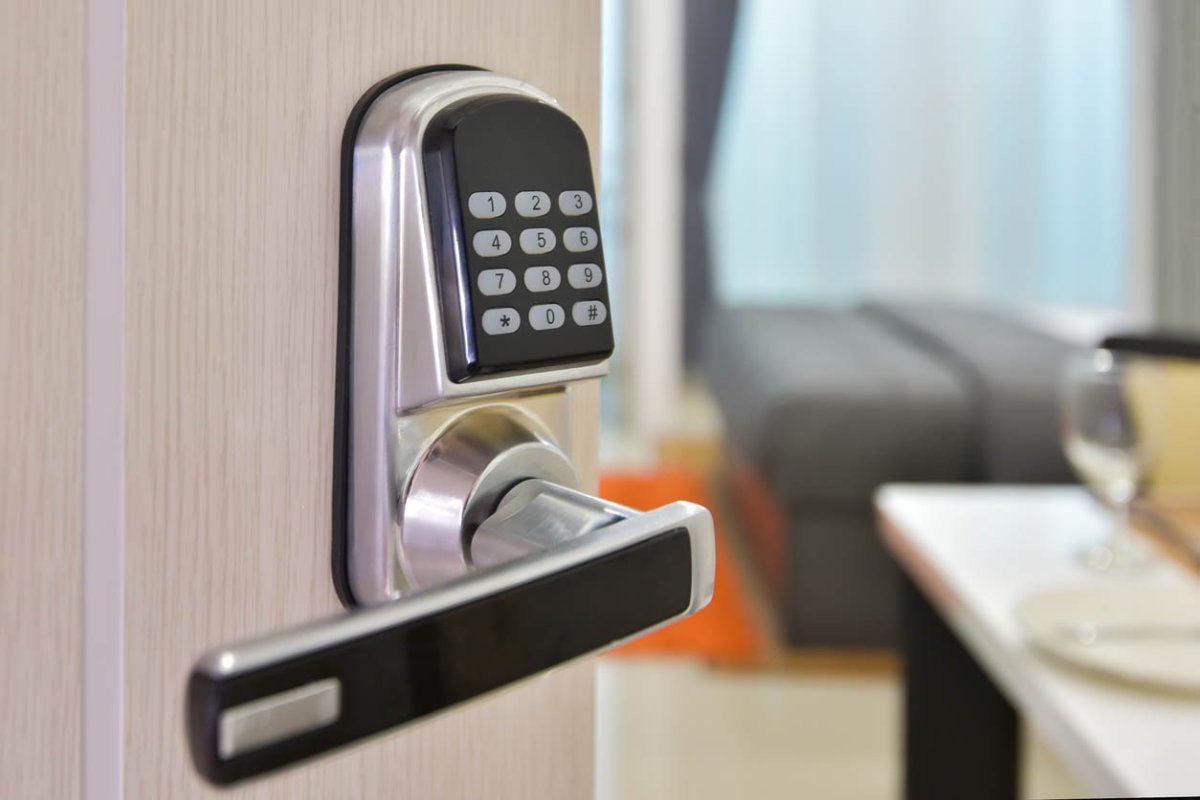We may earn revenue from the products available on this page and participate in affiliate programs. Learn More ›
Q: Our family regularly locks ourselves out of our home. It’s funny at first, and then just inconvenient and annoying. We’ve been considering installing a keyless door lock for this and other convenience reasons, but is it a safe and secure option?
A: Most people have, at some point or another, experienced that sinking feeling of hearing a door snap shut just as they realize their keys are on the other side. If you have a traditional door lock, reentry can mean calling a locksmith, hoping you can find the hide-a-key buried in your garden, or smashing your own window. Keyless door locks used to be a luxury, expensive and requiring professional installation and wiring. As home technology has advanced and smart homes have become more common, keyless door locks have followed, with easy homeowner-installed options and integration with smart devices. A keyless lock means you can be back in the house in moments via a keypad code, fingerprint, or quick swipe on your phone.
But are they secure? Or are they more secure than traditional locks? The answer is that they can be. If a keyless lock means you’re more likely to lock your doors every time you leave, less likely to hide a key underneath a doormat, or make tons of extra keys to share that you eventually lose track of, then yes, they can be more secure. However, traditional front door locks offer some options for modifications that add more security, and keyless locks have some weaknesses in their dependence on technology. Depending on your habits and needs, they can be a great option.
A lock may not be enough to protect your home—but a top-notch security system can be. Vivint’s professionally installed systems don’t just alert you to threats—they help both prevent and deter them. See Vivint’s cameras and services.
Keyless door locks don’t require a physical key the way traditional door locks do. They can be opened in a variety of ways, depending on the brand and model.
A keyless lock can lighten your load—literally. The fat ring of keys that weighs down your pocket can be slimmed because keyless locks don’t require a key at all.
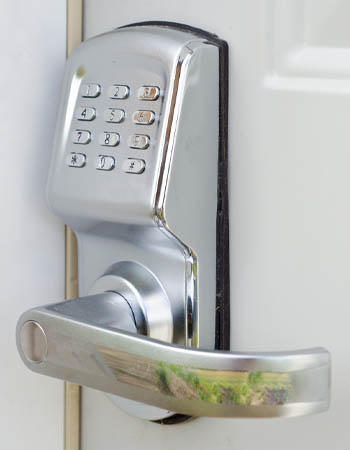
Keypad locks feature an integrated backlit 10-digit keypad into which homeowners enter a code to unlock the door. They’re simple, easy to program, and easy to use—as long as you frequently change the code so the keys don’t get worn down, and as long as you choose codes you can remember. All pretense of security is lost if you choose an easy-to-guess code like your birthday, house number, or telephone number. With a secure code, however, keypad locks offer many benefits. Users can share the code with children and extended family members so there are no keys to keep track of. Many keypad locks can be programmed so that temporary codes can be given to repair professionals, dog walkers, and babysitters, and some locks can limit the window of time that each code works. There’s nothing extra to carry or lose, and as most keypad locks are battery powered, they’ll always work (as long as you change the batteries on schedule).
Need a home security system? SimpliSafe can help. With a comprehensive whole-house solution, you can be prepared for the unexpected. View SimpliSafe systems and prices.
Fingerprint locks combine the keypad lock with additional technology: a fingerprint reader. Much like the fingerprint security pad on many cell phones, the fingerprint lock includes a small touch pad that reads your fingerprint and unlocks the door if the fingerprint is registered in the lock’s technology. The fingerprint scanner is paired with a keypad as backup and to allow the homeowner to share a code with others whose fingerprints they don’t want in the system. Some locks are now using a facial recognition scanner in the place of a fingerprint reader with a similar keypad backup.
Bluetooth-enabled door locks use Bluetooth and Wi-Fi technology to unlock the door via a paired fob or an app. Ideal for when your hands are full, fobs do not need to be held up to the lock or handled in any way: The fob will unlock the door as you approach from deep inside a pocket, purse, or bag. These locks can usually also be unlocked from an app, as the shared Bluetooth technology pairs the fob with the lock and the lock with the home’s Wi-Fi system, enabling control from anywhere with an app and giving you full control over who can enter your home, even when you’re not there. Bluetooth locks do have some problems in terms of connectivity and the potential for hacking, but those challenges can be overcome with careful security practices.
Frontpoint protects your home in an emergency, whether it’s a break-in, fire, medical emergency, and more. View Frontpoint products.
Depending on the type of keyless door lock, the ability to get into your home can be affected by power outages.
This is probably the most obvious weakness of some keyless locks. While some are battery powered, any lock that needs to be connected to a power source or the internet is at risk when there’s a power outage. Battery backup may power the lock itself, but Bluetooth locks require a connection to the home’s Wi-Fi system, so if the router has lost power, the door lock may be stuck in whatever position it was in when the power went out. Most can be manually opened from the interior, if there’s someone inside, but some lock in place until the power returns, which presents both a safety hazard and a problem getting into or out of your home.
Battery-powered locks and battery backups can stand up to this problem—sometimes. Like many things that aren’t needed often, it’s easy to forget to replace the backup batteries often. If that’s the case in your home, look for a lock that has an indicator light or sends a notification when the backup batteries are low, or schedule the replacements on your calendar so you’re not locked out if there’s a power failure.
Nearly every keyless lock on the market also includes a manual backup keyhole, but if your reason for choosing a keyless lock in the first place was to avoid carrying an extra key, it’s important to be realistic about the likelihood that you’ll have the backup key with you when you need it.
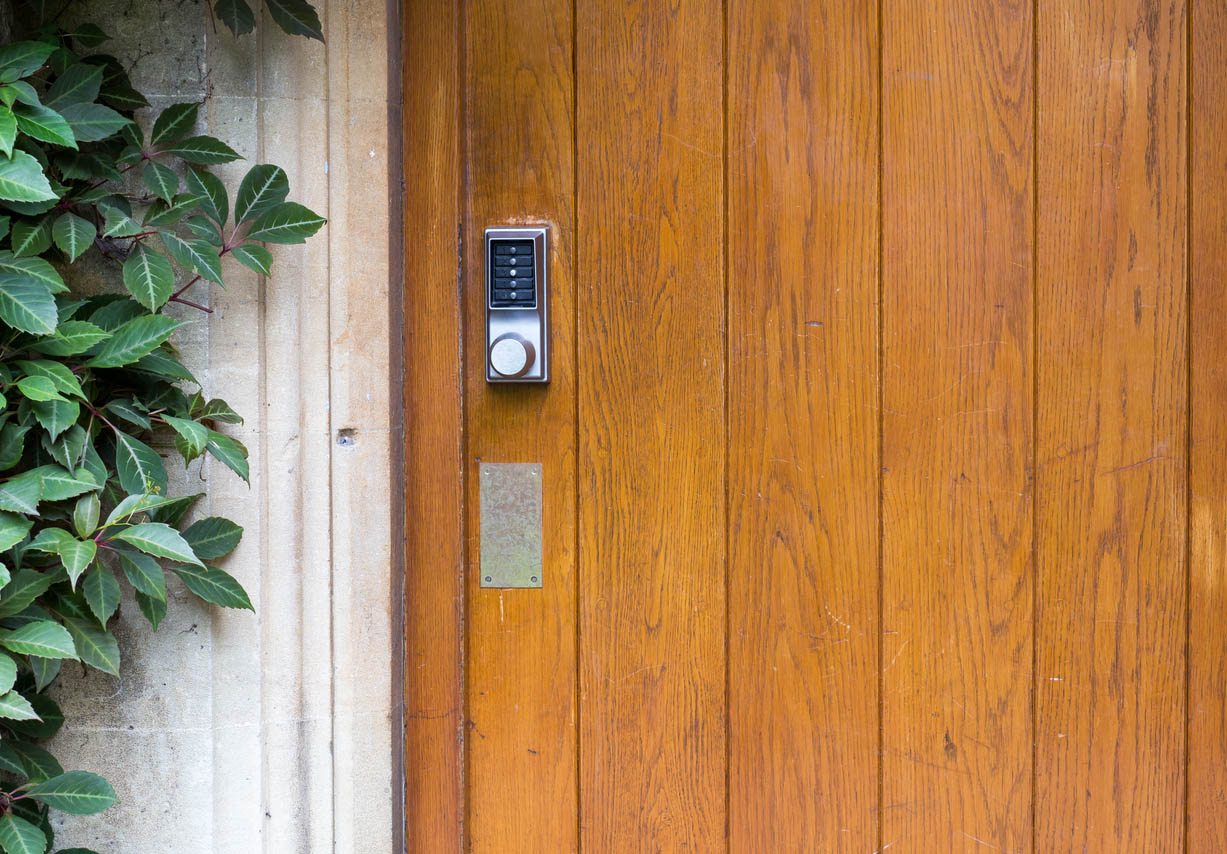
Keyless door locks can be used on their own or with a deadbolt that’s already installed.
Early criticisms of keyless locks stemmed from the fact that they were only available for handle locks or latch locks because the early versions weren’t powerful enough to force a deadbolt open or closed. As a result, homeowners would need to add a separate keyed deadbolt to their doors to properly secure their homes, negating the convenience factor of the keyless lock.
Luckily, this is no longer the case. Keyless locks are available in a wide range of configurations: doorknob locks, handle sets with coordinating deadbolts, add-on deadbolts, and full-plate locks that look elegant even on traditional doors. In addition, keyless locks that will retrofit your existing deadbolt by fastening a controller box over the existing switch are available, so if you want to keep your existing handle set for aesthetic reasons, you can add a keyless feature.
Deep Sentinel Home Security systems can make you and your family feel safe and secure with top-of-the-line equipment and live guards watching your home. View Deep Sentinel Home Security systems and prices.
Keyless door locks don’t require a professional to install them.
Technology-forward keyless locks must be difficult and expensive to install, right? Nope! All you’ll need to install one of these locks yourself are a few basic tools. The instructions will guide you through the process of removing the old lockset, making any necessary adjustments, and installing the new keyless lock in its place. If you’re uncomfortable doing the installation yourself, a handyman (or handy neighbor) can help you; the installation is quick, and there’s no need for the expense of a locksmith.
If you’ve chosen a lock that connects via Bluetooth or Wi-Fi, there’s a small technology hurdle, as you’ll have to connect the lock to your home network, download the appropriate mobile app, create an account, and connect to set the codes or register fingerprints or faces. Programmable locks will require some setup. But the locks come with excellent instructions and links to helpful videos online, and most have customer service lines where representatives are waiting to help you get set up if you’re having trouble.
Keyless door locks can work in tandem with a smart-home system.
It seems that nearly every aspect of the home can now be automated and programmed through smart-home devices. Lighting, temperature and HVAC, televisions, ovens and washing machines, alarm systems—even light bulbs can be controlled with a few swipes on a phone or tablet or a quick word with a smart-home assistant. Keyless locks are no exception. Integration with a smart-home system places all your smart-home controls in one place, so it’s easier to keep track of everything and also easier to maintain the highest level of security.
Protect your home and family with a top-notch security system. Vivint’s professionally installed systems don’t just alert you to threats—they help both prevent and deter them. See Vivint’s cameras and services.
One of the most reassuring features of a smart door lock is the ability to check to make sure that your doors are closed and locked, whether you’re getting ready for bed and can’t remember if you locked the back door or you’re 2 hours into a road trip and suddenly can’t find the muscle memory of turning a key. A quick check of the app will tell you that the doors are closed and locked—or not, but if they’re not locked, you can do that from the app as well. If they aren’t closed, well…you’ll have to call a helpful neighbor because smart devices can’t physically close your doors—yet. You may be able to close and lock the garage door if it’s powered by a smart garage door opener and lock, but the doors to the home will still need a human.
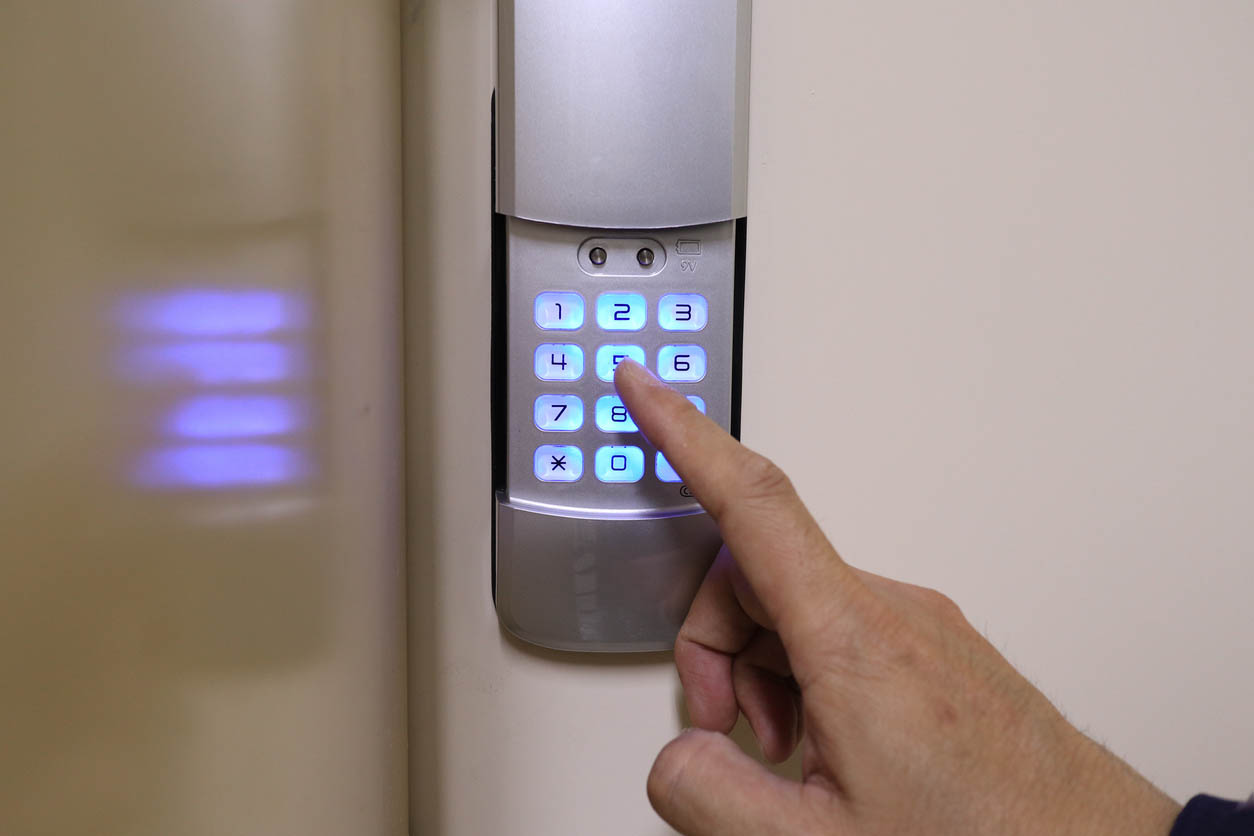
Keyless door locks aren’t necessarily more secure than traditional locks.
Every lock on the market, keyed or keyless, has a physical weakness: The lock is only as strong as the construction material, the length of the deadbolt, and the strength of the material the bolt slides into. Each of these factors affects the likelihood that the door can be kicked or shoved in, so bolstering them adds security.
The American National Standards Institute and Builders Hardware Manufacturers Association tests and rates locks to help homeowners choose the best strength for their needs. They test the locks to see how well they withstand the ways most home invaders might choose to try to enter: prying, impact to the door, impact to the lock, and other methods. The three grades determine the appropriate applications for the lock, and it’s recommended that you choose the strongest lock appropriate for your door for exterior door security. An ANSI Grade 1 lock is the strongest lock available. Locks categorized as Grade 1 are standard in commercial properties and offer the very best security on residential doors as well, but they are more expensive and can be quite industrial in appearance. As keyless locks become more common, however, the style aspect of Grade 1 locks is expanding. ANSI Grade 2 locks are very strong and durable, though less so than Grade 1. Grade 2 locks are available in more finishes and styles than Grade 1 and provide excellent security for residential settings. ANSI Grade 3 locks have the lowest rating, and while they do provide security, they are only appropriate for residential locks. They’re likely to have shorter deadbolts and be made of less-durable materials.
Need a home security system? SimpliSafe can help. With a comprehensive whole-house solution, you can be prepared for the unexpected. View SimpliSafe systems and prices.
Keyless locks are available in all three grades, so you can select the grade that is most appropriate for your home to make it as secure as possible. One additional item to check in terms of physical weakness: Most traditional locks offer the option to switch out the deadbolt for a longer bolt and to replace the strike plate on the lock with a steel housing, both of which increase the strength of the bolt. Because of the electronic component of keyless locks, most of them cannot be modified this way, so you’ll want to select one that already has a longer bolt and steel strike plate for maximum security.
Unlike traditional keyed locks, smart door locks have a second weak point: technology. Because they are electronic and often connected to a home network, they are open to hacking or infiltration. As your codes fly through the air, skilled hackers can pick up the code from a fob, or break into your Wi-Fi and access the keypad codes and gain access to your home. If you have the app stored on a phone without a strong password and lose the phone, anyone who picks it up can control the smart locks (and potentially many other things in your home). Because your home network is connected to everything, a hacker who isn’t even intending to access your locks may stumble upon them while trying to get into your bank account—and digital assistants like Amazon’s Alexa, Apple’s Siri, and the Google Home Assistant can become playthings for kids or guests and opened up to potential hacks by accident.
Lock manufacturers and smart-home device manufacturers are constantly improving their hardware and software to combat this danger, but you have some responsibilities here, too. Choosing a secure password for your router, your Wi-Fi, and your devices matters, as does changing it regularly. Making sure that your home networking devices are regularly updated to the latest firmware will make sure any known security gaps are repaired, and occasionally upgrading routers and modems can go a long way to making sure you’re as secure as you can be. Using the two-factor authentication offered by smart-home apps (and logging out of your app when you’re not using it) will add to your security. Finally, make sure that you understand the various connections and security options that digital home assistants such as Amazon’s Alexa, Apple’s Siri, and the Google Home Assistant make with your family and the outside world, as well as how to secure them, so that you can appropriately secure those as well.
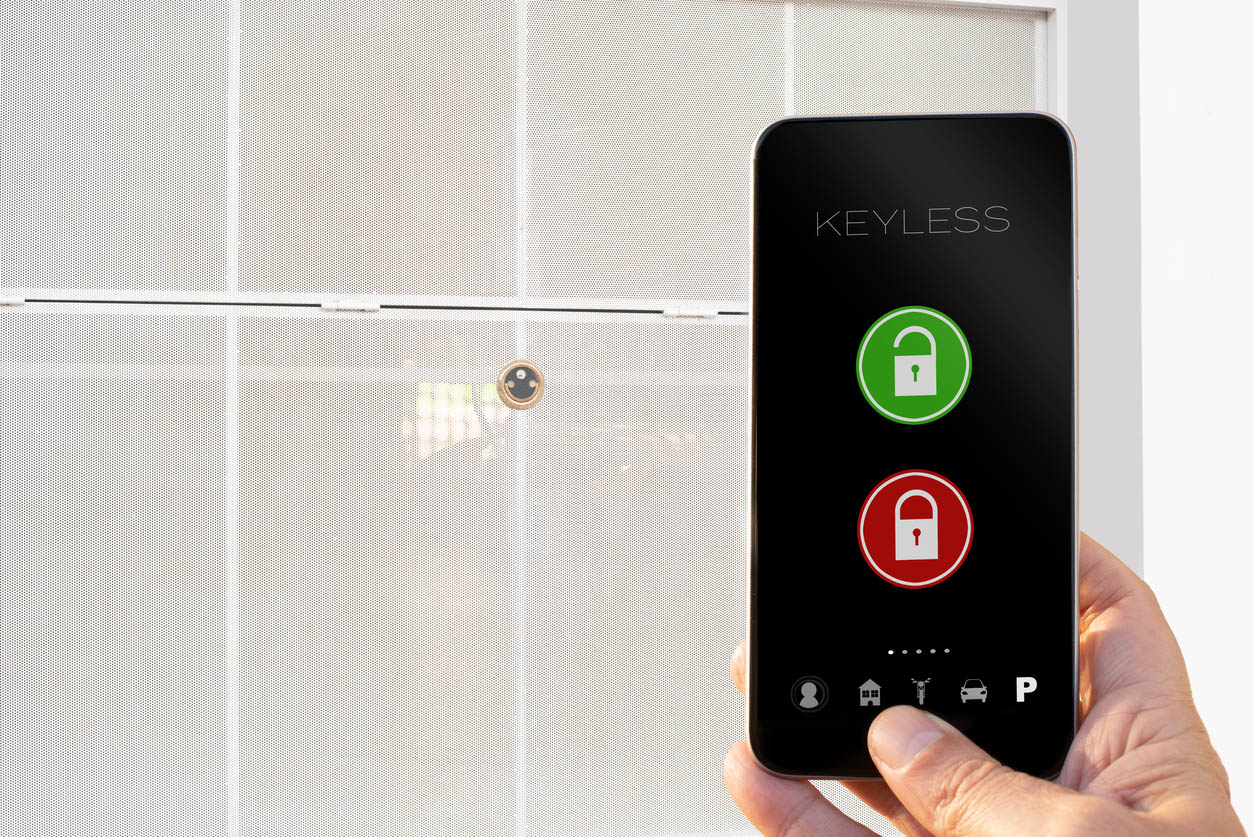
A keyless door lock can be the right choice for you and your home, depending on your habits and security needs.
For busy households that have a lot of people coming and going every day, a keyless lock can be a form of liberation: Without the need to constantly hand off keys, leave keys in hiding spots, keep keys stashed in backpacks, and making sure they all get returned, everyone can relax a bit. Programming codes into a keyless lock so everyone can get in when they need to (and only when they need to) will simply make life easier. Those with older family members who may need assistance on occasion may be reassured by knowing they can get in to help at a moment’s notice or unlock a door from another location to allow emergency personnel to enter, and any parent who has ever watched a gleeful toddler slam a door closed and then tried to cajole the child through a mail slot into unlocking the door will appreciate the option to simply let themselves back in.
On the other hand, those who find the extra layer of technology intimidating or confusing may just not feel safe with an electronically controlled lock. A plain keypad lock that is not connected to a home network may provide a great combination of security and convenience. And then there are others for whom a true sense of security will never be found behind anything but a solid deadbolt opened only with a key. That’s fine, too, because security is as much about your comfort and feeling of safety as it is about the physical lock keeping your door closed. For any one of these scenarios, having one of the best home security systems installed can bring extra peace of mind.
Depending on your lifestyle, a keyless door lock can be convenient and easy to use or a source of worry. Take a few moments to consider the maintenance and safety requirements a smart lock requires, along with the ease of installation and connectivity benefits, and decide if a keyless lock is the right choice for you.

